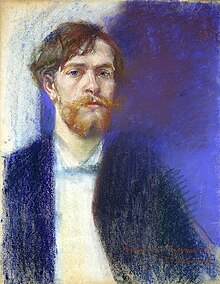Stanislaw Wyspiański
| Stanisław Wyspiański | |
|---|---|

Self-portrait, 1894
|
|
| Born | 15 January 1869 Kraków, Austrian Poland |
| Died |
28 November 1907 (aged 38) Kraków, Austrian Poland |
| Nationality | Polish |
| Education | School of Fine Arts in Kraków |
| Known for | Painting |
Stanisław Wyspiański (pronounced ['staˈɲiswaf vɨˈspjaɲskʲi]; 15 January 1869 – 28 November 1907) was a Polish playwright, painter and poet, as well as interior and furniture designer. A patriotic writer, he created a series of symbolic, national dramas within the artistic philosophy of the Young Poland Movement. Wyspiański was one of the most outstanding and multifaceted artists of his time in Poland under the foreign partitions. He successfully joined the trends of modernism with themes of the Polish folk tradition and Romantic history. Unofficially, he came to be known as the Fourth Polish Bard (in addition to the earlier Three Bards: Adam Mickiewicz, Juliusz Słowacki, and Zygmunt Krasiński).
Stanisław Wyspiański was born to Franciszek Wyspiański and Maria Rogowska. His father, a sculptor, owned an on Wawel Hill. His mother died of tuberculosis in 1876 when Stanisław was seven years old. Due to problems with alcohol, Stanisław's father could not fulfil his parental responsibilities. Stanisław was adopted by his aunt Joanna Stankiewiczowa and her husband Kazimierz. The Stankiewicz family belonged to a bourgeois intellectual class. In their house, Wyspiański became acquainted with painter Jan Matejko, who was a frequent visitor. Matejko soon recognized that the boy had artistic talent and gave him his first artistic guidance. Wyspiański attended Saint Anne's Secondary. The school was unique for several reasons. Firstly, although the Polish language was forbidden in educational institutions under foreign rule, the lectures in Saint Anne's Gymnasium were delivered in Polish. Secondly, the teacher's goal was to equip the students with a thorough knowledge of Polish history and literature. Thirdly, graduates of the school, including Lucjan Rydel, Stanisław Estreicher and Henryk Opieński, were considered prominent figures in Kraków's cultural life. As a student, Wyspiański took particular interest in art and literature. According to Joanna Stankiewiczowa, a young Stanisław portrayed small cottages, animals, plants, armors and decorations. Wyspiański also created a dramatic interpretation of Matejko's painting Stefan Batory pod Pskowem (Bathory at Pskov).
...
Wikipedia
